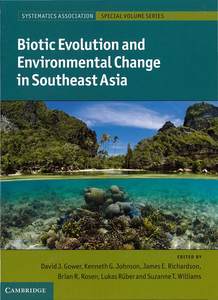Biodiversity hotspots, evolution and coral reef biogeography: a review
Bellwood, David R., Renema, Willem, and Rosen, Brian R. (2012) Biodiversity hotspots, evolution and coral reef biogeography: a review. In: Gower, David J., Johnson, Kenneth G., Richardson, James E., Rosen, Brian R., Rüber, Lukas, and Williams, Suzanne T., (eds.) Biotic Evolution and Environmental Change in Southeast Asia. The Systematics Association Special Volume Series, 82 . Cambridge University Press, New York, USA, pp. 216-245.
![[img]](https://researchonline.jcu.edu.au/23673/1.hassmallThumbnailVersion/23673_Bellwood_et_al_2012_Cover.jpg)
|
Image (JPEG) (Book Cover)
- Cover Image
Download (495kB) |
|
|
PDF (Published Version)
- Published Version
Restricted to Repository staff only |
Abstract
[Extract] It is widely acknowledged that the Southeast Asian region is an area of outstanding biological and geological interest. It is an area of exceptional biodiversity, which contains both marine and terrestrial biodiversity hotspots (Myers et al. 2000, Roberts et al. 2002). The convoluted and still highly active tectonic history of the region has resulted in a complex archipelago characterised by highly localised terrestrial faunas with large numbers of endemic species (Hall 2002, Sodhi et al. 2004). Terrestrial hotspots are defined as areas of exceptional endemism (usually combined with some measure of environmental damage) (Myers et al. 2000). This focus on endemism has resulted in the identification of three small regional terrestrial hotspots within the Indo-Australian Archipelago (IAA). The marine system stands in marked contrast to the terrestrial pattern, with the IAA sitting in the middle of a single massive global marine hotspot. This feature dominates patterns of tropical marine biodiversity and spans over two thirds of the world's tropical equatorial oceans. This pattern is observed in most tropical shallow marine taxa (see review of Hoeksema 2007). Although the exact location of the most diverse area differs between taxa, in all cases, the IAA contains the hottest part of the world's largest biodiversity hotspot (Fig 9.1).
| Item ID: | 23673 |
|---|---|
| Item Type: | Book Chapter (Research - B1) |
| ISBN: | 978-1-107-00130-5 |
| Date Deposited: | 31 Oct 2012 00:37 |
| FoR Codes: | 05 ENVIRONMENTAL SCIENCES > 0501 Ecological Applications > 050102 Ecosystem Function @ 33% 06 BIOLOGICAL SCIENCES > 0603 Evolutionary Biology > 060302 Biogeography and Phylogeography @ 34% 06 BIOLOGICAL SCIENCES > 0603 Evolutionary Biology > 060301 Animal Systematics and Taxonomy @ 33% |
| SEO Codes: | 96 ENVIRONMENT > 9605 Ecosystem Assessment and Management > 960503 Ecosystem Assessment and Management of Coastal and Estuarine Environments @ 33% 96 ENVIRONMENT > 9605 Ecosystem Assessment and Management > 960507 Ecosystem Assessment and Management of Marine Environments @ 33% 96 ENVIRONMENT > 9608 Flora, Fauna and Biodiversity > 960808 Marine Flora, Fauna and Biodiversity @ 34% |
| Downloads: |
Total: 807 Last 12 Months: 9 |
| More Statistics |



